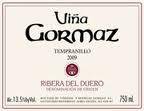Note from Scott: Sign up to be eligible to win a gift certificate to Eola Wine Company. Click this link for details.
As one of the leading Old World wine producing countries, Spain continues to churn out some of the best wines in the  world. As the world’s third largest wine producing nation, behind Italy and France respectively, Spain has literally had thousands of years to get it right. And while Spain is the most widely planted wine producing nation, 80 percent of the country’s wine production comes from only 20 different grape varietals. Amongst one of Spain’s centuries old regions is the Denominacion de Origen (D.O.) of Ribera del Duero, located along the Duero river on the northern plateau of the Iberian peninsula. While this region has long been established for wine growing and production, it was, until the 1970s, mostly recognized as the location of Vega Sicilia, one of Spain’s most notable wineries.
world. As the world’s third largest wine producing nation, behind Italy and France respectively, Spain has literally had thousands of years to get it right. And while Spain is the most widely planted wine producing nation, 80 percent of the country’s wine production comes from only 20 different grape varietals. Amongst one of Spain’s centuries old regions is the Denominacion de Origen (D.O.) of Ribera del Duero, located along the Duero river on the northern plateau of the Iberian peninsula. While this region has long been established for wine growing and production, it was, until the 1970s, mostly recognized as the location of Vega Sicilia, one of Spain’s most notable wineries.
So what happened in the 1970s to change everything? In a word, tempranillo. And it is possibly one of the fastest growing favorites of the red wine drinking world. That is not to say that Spanish winemakers had been neglecting or even overlooking the grape. On the contrary, the renowned region of Rioja is best known for growing and using tempranillo—albeit blending it with other varietals such as merlot, malbec, grenache, cabernet sauvignon, and the like.
Then one day, Alejandro Fernandez began making his Ribera del Duero wine predominantly from tempranillo grapes, showcasing what the grape has to offer, while limiting or altogether leaving out other varietals. The change occurred in that popular wines like those from Rioja were not known for having the concentrated, fruit-driven flavors like that of “pure” tempranillos first made by winemakers like Fernandez. Thus, the style, in conjunction with the region, grew in popularity through the 1980s and 90s. Over the past 40 years, this region has grown increasingly well-known for its production of tempranillo-dominated wines.
This was controversial to Rioja winemakers, but somewhat of a revelation to growers in Ribera del Duero. While tempranillo ages gracefully in oak, winemakers learned to reap the benefits of the cooler Ribera del Duero climate, which produces approachable tempranillos that can remain un-oaked and be consumed young.
A good example of this is the Vina Gormaz 2008 Tempranillo, available for $7 a glass/$28 a bottle at Eola Wine Company. Lighter to medium bodied, this wine is brick red in color and showcases somewhat classic tempranillo characteristics. While the nose is concentrated, it does not come off as predominantly fruit-driven. However, nuances of plum and a sort of candied cherry (Runts? Fruit Gushers?) are detectable beneath a lush, maple-vanilla character. And while this wine is not considerably complex, it is approachable, balanced, and finishes clean. This might be a great choice for someone looking to transition from a lighter-bodied pinot noir to a fuller-bodied red.
Showcasing Spain’s versatility in terroir, climate and style, is quite a different wine from the D.O. Terra Alta region. The 2006 Portal from the Cellar Pinol is considerably more Old World in personality than the Vina Gormaz. For starters, where the Vina Gormaz tempranillo was “naked,” the Portal was aged in a trio of oak, consisting of French, American and Hungarian. Itself a varietal blend of 20% garnacha, 20% tempranillo, 20% syrah, 20% merlot, and 20% cabernet sauvignon, this wine shows its age in its similar brick-red color. It has more viscosity than the tempranillo, starts off hot, and offers a relatively complex nose of cherry licorice, cola, spice, oak, meat, and cassis. Mouthfeel is substantial (medium bodied) and medium-dry, but not “sumptuous” as promised by the label. And, as the nose cools, elements of brine begin to show through, indicative of the Mediterranean climate of the region. The highly mineral components of the finish (possibly due to the “calcareous clay” soil) are eventually replaced by mint and eucalyptus and, while it could be enjoyed solo, this wine would pair wonderfully with lamb and Greek yogurt sauce. Coming soon to Eola’s by-the-glass menu, there is something mysterious and a bit fascinating about this wine which is not to be missed.
Keep in mind, there is more where this came from. Not only is there an impressive variety of Spanish reds on Eola’s menu, (the Vinos Sin-Ley Garnache from Priorat and the Altos de la Hoya Monastrell from Jumilla are two wines from exceptional regions,) there is a variety of other Spanish styles as well: Try the fabulous Paco & Lola Albarino from Rias Baixas, the sprightly Villa Franca Cava from Penedes, or the decadent Alvear Pedro Ximenez from Montilla for a truly worldly experience.
{fblike}










